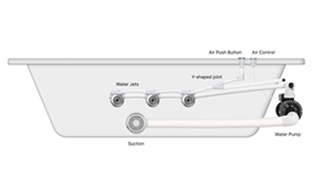Air Jets vs. Water Jets in Spa Systems: Choosing the Right Solution for Each Use Case
What Are Spa Air Jets and Water Jets?
How to Clean and Maintain Spa Air Jets and Water Jets?
Aspect | Air Jets | Water Jets |
Primary focus | Inspect check valve, prevent water backflow, and keep the air system dry | Clean internal jet cavity, prevent clogging, and remove scale and biofilm buildup |
| Routine maintenance | Run a post-use air-drying cycle; quick and easy | Flush the water circuit after each use; periodically apply descaling or sanitizing solution |
| Maintenance frequency | Low: Inspect the check valve quarterly; routine drying after use is sufficient | High: Weekly jet flow check; monthly deep cleaning with disinfectants |
| Skill level required | Low: Easy to maintain; suitable for home or hotel use | Moderate to High: Requires knowledge of chemical dosages, pump cycles, and jet disassembly |
| System maintenance cost | Lower: Minimal consumables needed; low-intensity upkeep | Medium: Requires periodic cleaning agents, occasional replacement of jets, pumps, or filters |
Performance Over Time: Spa Air Jets vs. Spa Water Jets
Air Jet System / Bubble System | Water Jet System / Massage System | |
| Driving Equipment | Blower | Water Pump |
Rated Power Range | Typically 300–800W (depending on airflow and tub size) | Typically 750–1500W (higher pressure = higher consumption) |
| Instantaneous Load Behavior | Stable power draw, low startup surge | High startup current, significant voltage drop during pump activation |
| Energy Type | High-speed, low-torque air drive with self-cooling | High-load hydraulic system requiring forced cooling |
| Long-Term Energy Cost | Low: suitable for high-frequency usage environments | High: requires routine monitoring of wiring and pump heating status |

Air Jets | Water Jets | |
Exposure to Corrosive Media | Primarily air; jets remain mostly dry—minimal corrosion risk | Continuous water exposure; prone to scale and corrosion, especially with hard water |
| Structural Wear Resistance | No high-pressure flow; virtually no mechanical wear | Constant hydraulic impact; adjustable/rotating parts are prone to friction wear and sticking |
| Clogging Risk | Minimal (air only, no contaminants) | High; susceptible to blockage from soap, skin debris, algae—especially at jets and moving parts |
| Dependency on Cleaning Frequency | Optional cleaning; low-frequency maintenance has minimal impact on lifespan | Cleaning frequency directly affects lifespan; lack of cleaning leads to early failure |
| Expected Service Life | Typically 8–10+ years | Typically 4–6 years; may be shorter with frequent use or poor maintenance |
Hybrid Jet Configuration: Combining the Best of Air Jets and Water Jets
| Body Zone | Suggested Jet Type |
| Back & Lower Back | Water jets (for targeted, high-pressure massage) |
| Legs & Soles of Feet | Water jets or rotating jets (to stimulate blood circulation) |
| Shoulders & Neck | Optional rotating water jets or static pressure jets |
Full-body Surround / Hips / Sides | Air jets (for gentle bubbles and even coverage) |
Tub Bottom / Backrest Areas | Air jets (to soften and balance massage rhythm) |

Differences in Massage Effect between Spa Air Jets and Water Jets
Air Jets | Water Jets | |
Intensity | Gentle & Soft | Powerful & Penetrative |
Coverage | Full-body coverage | Targeted local stimulation |
Relaxation | Soothing, meditative | Muscle relief, therapeutic |
| Therapeutic Logic | Bubble Microvibration + Oxygen Stimulation + Thermostatic Bath | High-pressure water jet impact + localised circulation enhancement + physical traction |
| Duration | Suitable for long sessions | Quick, targeted sessions |
| Noise Level | Quiet or bubbling sound | Audible pump vibration |
| Focus Area | Sleep disorders, stress anxiety, mild nervousness | Exercise fatigue, stiff shoulders and neck, low back pain, post-operative muscle rehabilitation |
Recommended Use Cases of Spa Air Jets and Spa Water Jets
| Air Jet-Dominant | Water Jet-Dominant | Balanced Hybrid | |
| Recommended Applications | - High-end home soaking tubs
- Hotel in-room silent massage tubs
- Beauty and wellness spas
- Assisted-living bathtubs | - Rehabilitation therapy tubs
- Post-workout spa zones
- Functional hydrotherapy pools
- Athlete recovery whirlpools | - Family-sized multifunction tubs
- Luxury hotel suite spas
- Premium wellness & rehab centers
- Export-oriented all-in-one spa systems |
| B2B Buyer Profile | - OEM brands of home bathtubs
- Hotel spa contractors
- Spa and beauty center buyers | - Rehab center procurement managers
- Gym and fitness investors
- Medical hydrotherapy equipment developers | - Export-focused OEMs
- Developers of high-end hospitality spas
- Operators of integrated wellness projects |
| End-User Profile (B2C) | - Female and elderly users who prefer quiet soaking
- Users seeking emotional relief and mindfulness
- Individuals sensitive to water pressure | - Office workers with muscle tension
- Fitness and sports recovery users
- Patients requiring low-impact rehabilitation | - Families with diverse usage needs
- Middle-aged and elderly wellness users
- High-income consumers seeking multifunctional spa experiences |

































